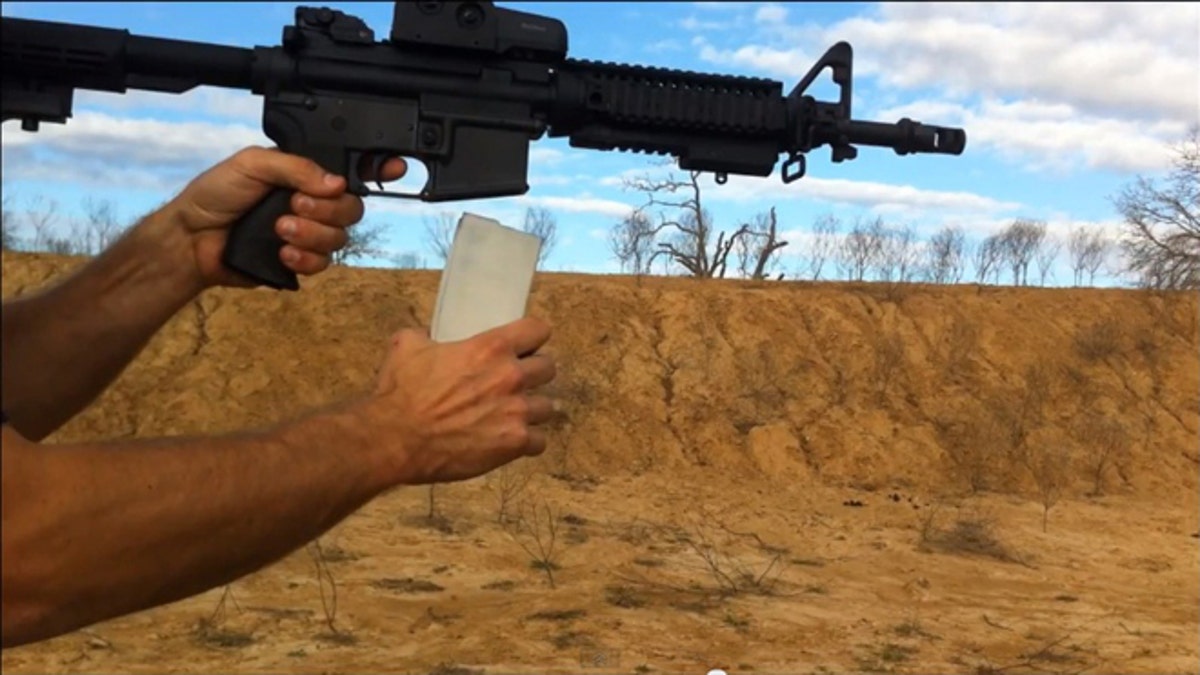
Cody Wilson of Defense Distributed testing out the "Cuomo Clip" -- a 3D printed gun clip. ((DefenseDistributed.com))
With controversy swirling over gun control and public safety, that fact that it’s possible for regular people to design and 3D print gun parts at home has become a matter of great public concern. Recent years have seen a proliferation of personal-scale manufacturing systems, such as homemade 3D printers, desktop CNC mills and laser cutters. While such technologies are likely to have a profound positive impact on technological innovation, they may carry some hidden perils.
Making your own gun has always been technically possible, even before the advent of low-cost design and manufacturing tools. What has changed is that, as these technologies continue to improve and drop in price, making gun parts has become easier and can be done more discreetly.
One expert successfully printed a complete working handgun out of nylon.
Today, with just a design blueprint, a general purpose 3D printer, and some durable printing plastic, people with relatively low engineering skills can fabricate a working gun in the privacy of their own home.
One expert successfully printed a complete working handgun out of nylon.
3D printers and better design software may be disruptive but they’re certainly not the first technologies to introduce both promise and peril. For example, before desktop publishing became commonplace, currency counterfeiting used to be a skilled profession, requiring experience in offset printing and access to specialized equipment. Today, however, according to a recent public service bulletin issued by the U.S. secret service, making counterfeit currency has become much easier than it used to be.
The Secret Service bulletin notes that modern counterfeiters need only “basic computer training and skills afforded by trial and error, and public education.” The Secret Service estimates that before 1995, fewer than one percent of fake bills were made using computers and laser printers.Just 5 years later, in 2000, about half of the counterfeit bills confiscated by federal agents had been designed on a computer and printed out on a high-end color printer.
Counterfeit money may cause economic harm. However, 3D printed counterfeit goods and unauthorized weapons pose a more direct threat, that of severe or even fatal bodily harm.
The danger is not just that criminals will make guns -- there are already easier ways for criminals to get guns today through various black market channels. The larger concern is that with emerging home-manufacturing tools, enthusiastic kids and hobbyists might fabricate shoddy firearms and accidentally injure themselves in the process of trying them out.
Criminals who do embrace 3D printed guns will also pose a new threat: custom-made weapons and accessories could be designed to look nothing like mainstream guns today, making their detection more difficult.
In addition, a metal-detector would fail to detect a gun printed of plastic or nylon. If you Google “3D printing guns,” you’ll discover a number of demonstrations of home-made, 3D printed working gun parts made from standard ABS plastic, the same material that LEGOS are made out of. One expert successfully printed a complete working handgun out of nylon.
These engineering projects demonstrate that making and modifying gun accessories such as high capacity magazines is a relatively straightforward process. True, it’s unlikely that somebody could fabricate a military-grade sniper rifle at home with a 3D printer or an automatic weapon that could fire 10 rounds a second. However, even a crude but functioning 3D printed gun would be a dangerous weapon – and the necessary technology is only improving.
Well-written laws created with the best of intentions can’t be enforced if they don’t keep up with technology. If we assume that at-home, illicit production of gun parts will follow the path of desktop-printed counterfeit dollar bills, more stringent law enforcement at the point of retail may not be that effective.
Other proposed gun control solutions such as pouring resources into setting up checkpoints to screen for the presence of metal gun parts might become less effective in the future, given the possibility of 3D printed, polymer-based gun parts.
A more productive question to ask is a practical one: which would be easier to detect (and thus control) -- actual mechanical gun parts or the gun powder required to make a gun work?
As 3D printed and arbitrarily-shaped plastic firearms become increasingly more difficult to detect using traditional screening techniques, perhaps a gun control solution worth exploring might be to impose legal limitations on gunpowder and explosives.
It’s true that gunpowder is a simple chemical concoction and not difficult to make at home. However, as chemical sensing technologies advance, detecting gunpowder may be a simpler and more effective solution.
When it comes to powerful technology tools, legal restrictions can only do so much. 3D printing and other personal-scale manufacturing technologies will continue to drop in price and improve in capacity. Trying to stop the development of these technologies is like trying to hold back a tidal wave.
It’s not a constructive solution to stifle the technological advancement of desktop manufacturing technology and design software because it can be used to make weapons. After all, high schools still teach chemistry -- despite the fact that students could use that knowledge to create drugs or explosives.
The answer lies in using technology to regulate technology. The best solution to keep the lid on this explosive issue would be an intelligent blend of realistic gun control regulations, combined with investment in detection technologies that acknowledge that 3D printed guns may not shaped like guns, may not be sold in stores and may not even be made of metal.
